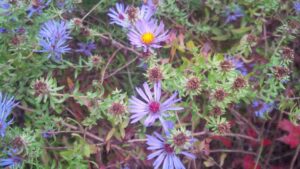 There was a time—though I hardly remember it now–when I had no asters in my front garden. Then I planted one small pot of a tall, pink-flowered aster named ‘Alma Potschke’. ‘Alma’ prospered—so much so that now, if I didn’t pull out some of the seedlings every year, I would probably have thousands of ‘Alma Potschke’offspring. Not only do I pull out seedlings, but the deer crop the young plants regularly during the summer months. Each and every deer-besieged ‘Alma’ responds by branching out and producing more flowers, which ultimately produce more seeds, which in turn germinate and become next year’s seedlings.
There was a time—though I hardly remember it now–when I had no asters in my front garden. Then I planted one small pot of a tall, pink-flowered aster named ‘Alma Potschke’. ‘Alma’ prospered—so much so that now, if I didn’t pull out some of the seedlings every year, I would probably have thousands of ‘Alma Potschke’offspring. Not only do I pull out seedlings, but the deer crop the young plants regularly during the summer months. Each and every deer-besieged ‘Alma’ responds by branching out and producing more flowers, which ultimately produce more seeds, which in turn germinate and become next year’s seedlings.
‘Alma’s proliferation provides yet another example of what happens when bees, genetics and plant proximity collide. The original plant was medium pink. ‘Alma’s many offspring are light pink, rose pink, pink-purple, and other shades too numerous to mention. The genetic soup has been stirred and the result is breathtaking. I take full credit, though I deserve none of it.
Some time ago, I decided that I wanted a bit of blue to complement the many shades of pink offered up by ‘Alma’s offspring. I purchased one of the most popular blue-flowered asters, ‘Monch’, a hybrid of Frikart’s aster, or, more properly, Aster x frikartii ‘Monch’.
‘Monch’ grows to about two feet tall or more, with gently arching stems and medium green oblong leaves. In one year, my original plant grew to be at least three feet across, covering itself with hundreds of the characteristic two-inch, blue, daisy-like flowers.
That was only the beginning. Vigor is one of ‘Monch’s strong suits, rivaling ‘Alma’ in reproductive enthusiasm. Because of the number of buds on each of my plants, ‘Monch’ seems to go on forever, blooming for about a month in September and October.
After the original aster’s second year I took a piece of it and planted it in my lower back garden. After the third year, I made room for another division in my front strip garden. The ‘Monch’ divisions experienced about five seconds of transplant shock and then produced an avalanche of blooms. The result is billowing clouds of blue in each location.
‘Monch’ is quite youthful looking for a plant that is nearly one hundred years old. Introduced in 1918 by Swiss nurseryman and plant breeder Karl Ludwig Frikart, it was named for a mountain in the Alps. English garden writer Val Bourne described ‘Monch’ as “the longest flowering aster [ever] bred.”
Frikart was aiming for asters that were drought tolerant as well as beautiful. To achieve that goal, he crossed two tolerant species, both native to mountainous regions. One was the blue-flowered Italian aster or Aster amellus, native to central and southeastern Europe; the other a pink-flowered Himalayan species, Thompson’s aster, or Aster thompsonii. The crosses produced four offspring that Frikart thought good enough to market. The varieties were ‘Monch,’ ‘Wonder of Staffa,’ ‘Eiger’ and ‘Jungfrau.’ ‘Wonder of Staffa’ is very similar to ‘Monch’ in flower color and configuration. My trusty 1947 edition of the Wayside Gardens catalog offers it and it is still with us. ‘Jungfrau,’ now more widely available in Europe than in the United States, is more compact and probably better suited to smaller gardens or even container culture. ‘Eiger’ is probably much like its siblings, but it seems to have almost disappeared from commerce.
Few breeders have crossed the two parent species since, but ‘Monch’ and its siblings got a lovely half sister in 1964 when English breeder Alan Bloom crossed varieties of the Thompson’s and Italian asters to produce the pinkish-purple ‘Flora’s Delight.’
In the history of horticulture, one hundred years is not very long, but in the history of commercial horticulture—especially in our current amped-up, social media-driven environment where fads succeed each other with lightening speed–one hundred years is an eternity. ‘Monch’ has to be both tough and fashionable to stay current.
My original ‘Monch’ and its tough offspring have survived nicely in heavy clay soil, albeit amended with organic material. The Frikart’s asters in general prefer soil that is better drained and closer to the mountain environments favored by their parent species. If you are planting in areas with heavy clay, mix lots of compost, grit or sand with the loose soil at the bottom of the planting hole. Situate the plants in a sunny location and they will do the rest. It’s best to plant and divide in spring, though if someone offers you a ‘Monch’ or ‘Wonder of Staffa’ division in the next two weeks, take it and install it promptly. You will have plenty of blooms next fall.
Some local nurseries may offer end-of-season bargains on Frikart’s asters. If not, order from Digging Dog Nursery, 31101 Middle Ridge Road, Albion, CA 95410; (707) 937-1130; www.diggingdog.com.
